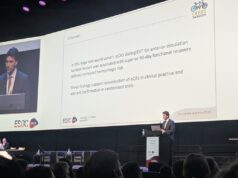
A randomised controlled trial (RCT) involving 300 patients found that functional outcomes among basilar artery occlusion stroke patients “did not differ significantly” with endovascular therapy (EVT) compared to standard medical care. Nevertheless, writing in the New England Journal of Medicine (NEJM), the study’s authors state that “the results of this trial may not exclude a substantial benefit of EVT”—with larger trials now being needed to determine the efficacy and safety of EVT for basilar artery occlusion.
This trial was based on information acquired from the prospective BASICS (Basilar artery international cooperation study) registry, which collected data on EVT versus intravenous (IV) thrombolysis between 2002 and 2007, and also follows the 2020 BEST (Endovascular treatment versus standard medical treatment for vertebrobasilar artery occlusion) trial—a randomised trial assessing endovascular treatment of basilar artery occlusion that was discontinued before its intended enrolment due to poor recruitment and a high rate of crossover between the medical care and EVT groups. Both of these studies also failed to fully demonstrate the superiority of EVT over standard medical therapy.
The latest major study in this space, the BASICS trial, was conducted by Wouter J Schonewille (St Antonius Hospital, Nieuwegein, The Netherlands) and colleagues, who—writing in NEJM—state: “Few patients with basilar artery occlusion have been included in major trials of EVT, which have mainly enrolled patients with strokes in the anterior cerebral circulation. The vascular anatomy, clinical presentation, and severity of neurologic deficit, in patients with basilar artery occlusion differ from those in patients with anterior circulation strokes. These differences suggest that trials of endovascular treatment should be conducted independently for patients with strokes in the basilar artery territory.”
However, after the results of this trial showed no significant benefit of EVT versus standard medical therapy—which involved close to 80% of patients receiving IV thrombolysis in both treatment arms—Schonewille told NeuroNews that “true equipoise remains regarding the efficacy of EVT in patients with a minor deficit”. He added: “The BASICS registry and trial both suggest that patients with a minor deficit do better with IV thrombolysis alone while, in clinical practice, treating physicians still feel uncomfortable withholding EVT. If anything, this trial shows that EVT is less effective in basilar artery occlusion compared to anterior circulation occlusion—so, we do have to improve our treatment approach in basilar artery occlusion.”
The BASICS trial was a multicentre, open-label, international RCT conducted across 23 centres in seven countries, from October 2011 through December 2019, involving patients with strokes due to basilar artery occlusion. The study’s researchers compared the efficacy and safety of EVT—initiated within six hours after the estimated time of basilar artery occlusion—with those of standard medical therapy.
The primary outcome was a favourable functional result, defined as a score of zero-to-three on the modified Rankin scale at 90 days, with the primary safety outcomes being symptomatic intracranial haemorrhage detected via neuroimaging within three days after the initiation of treatment, and mortality at 90 days. Secondary clinical outcomes were an excellent functional result, defined as a modified Rankin scale score of zero-to-two; National Institutes of Health Stroke Scale (NIHSS) score at 24 hours; distribution of modified Rankin scale scores; and health-related quality of life at 90 days.
Some 300 of 424 eligible patients were randomly assigned to a trial group, with 154 patients (age=66.8±13.1 years; 35.1% female [n=54]) assigned to the endovascular group to receive EVT plus standard medical therapy, and 146 (age=67.2±11.9 years; 34.2% female [n=50]) assigned to the medical treatment group to receive standard medical therapy alone. Crossover from one treatment group to the other occurred in three of 154 patients assigned to the endovascular group (1.9%) and seven of 146 patients assigned to the medical treatment group (4.8%). No patients had been lost to follow-up at 90 days.
Schonewille et al report that, in the intention-to-treat analysis, 68 of 154 patients (44.2%) in the endovascular group had a favourable functional outcome, compared to 55 of 146 patients (37.7%) in the medical treatment group. Regarding secondary outcomes, a total of 54 patients (35.1%) in the endovascular group and 44 patients (30.1%) in the medical treatment group demonstrated an excellent modified Rankin scale score.
Patency of the basilar artery at 24 hours, assessed by means of computed tomography angiography (CTA), was 84.5% in the endovascular group and 56.3% in the medical group—although Schonewille stated that, “as the trial did not show a significant benefit of EVT over best medical therapy, this higher patency rate is not clinically significant”, adding that this finding simply suggests “EVT more often leads to futile recanalisation”. Subgroup analysis also indicated median NIHSS scores at 24 hours of 11 and 15 in the endovascular and medical treatment groups, respectively.
In terms of the trial’s safety endpoints, mortality at 90 days was 38.3% in the endovascular group and 43.2% in the medical treatment group, and the risk of symptomatic intracranial haemorrhage within three days after the initiation of treatment was 4.5% in the endovascular group and 0.7% in the medical care group. Schonewille et al also note that malignant brain oedema occurred in 17 patients (11%) in the EVT group and in seven patients (4.8%) in the medical treatment group.
Despite there being “no statistically significant difference” in primary outcomes between the two groups assessed in the trial, the authors conclude that the upper limit of the 95% confidence interval in the risk ratio of 1.50 “cannot exclude the possibility” of benefit from EVT. “The trial therefore did not show an advantage of EVT over medical therapy, but these findings may be inconclusive” they add. “These results may inform the design of future trials in this field, for which recruitment and implementation have been difficult.” The authors also allude to the ongoing BAOCHE (Basilar artery occlusion Chinese endovascular) trial, which is assessing the efficacy of EVT more than six hours after symptom onset in patients with basilar artery occlusion, stating that it “may inform the results of the current [BASICS] trial” too.
Speaking to NeuroNews, Schonewille said: “Besides the time window, the main difference between the BAOCHE and BASICS trials is that, in BASICS, 80% of patients in both treatment arms were treated with IV thrombolysis, while patients in BAOCHE are either ineligible for IV thrombolysis or have received IV thrombolysis alteplase therapy without recanalisation. This trial will therefore not be able to show if EVT is superior to IV thrombolysis beyond six hours after symptom onset—but, a positive result, showing efficacy of EVT, should lead to a new trial testing the efficacy of EVT versus IV thrombolysis in the late time window.”
Regarding further research directions, Schonewille also proposed that future studies “should focus on improving patient selection and treatment approaches”, adding that large, multicentre international registries ought to look for imaging profiles that could identify patients with a minor deficit, at a heightened risk of subsequent deterioration, and those with a severe deficit and a fair chance of a favourable outcome, as these patients are more likely to benefit from EVT.
“Patients with basilar artery occlusion may benefit from IV thrombolysis, EVT, or both,” Schonewille stated. “The main benefit of IV thrombolysis is that it is easy to use and available in all primary stroke hospitals, with a low complication rate. Unless contra-indicated, patients with basilar artery occlusion should therefore be treated with IV thrombolysis. There is no doubt that EVT leads to higher recanalisation rates, but with a higher risk of haemorrhagic complications and the potential risk of occluding perforating arteries with mechanical manipulation of the clot. EVT should be reserved for patients with a low likelihood of a favourable outcome without EVT—whereby EVT is worth the risk. Hopefully, future research will help us to identify these patients.”










